#star_cluster
Link
The research team studied the planetary nebula's central star in the star cluster, determining that it had lost 70% of its mass over its lifetime. It also turned out that the star has an unusual chemical composition and does not contain hydrogen. Stars like our Sun end their lives as white dwarfs. Some of them are surrounded by a planetary nebula, consisting of gas ejected by a dying star just before the outburst. An international research team led by Professor Klaus Werner from the Institute of Astronomy and Astrophysics at the University of Tübingen studied the central star of a planetary nebula located in an open star cluster. Scientists were able to accurately determine the mass that the central star lost during its life. There are more than a thousand open star clusters in our Galaxy. Each of them includes up to several thousand stars that were formed from a dense cloud of gas and dust. “The stars in the cluster are of the same age, and this is of particular importance for astrophysics,” says Klaus Werner. They differ only in their mass. “The greater the mass of a star, the faster it consumes its nuclear fuel, burning hydrogen into helium. So the life of a large star is shorter and it turns into a white dwarf faster,” he explains. [caption id="attachment_68877" align="aligncenter" width="780"] nebula Messier 37[/caption] Observation of a star cluster shows the development of stars of different masses at the same age. “In astronomy, star clusters can be used as a kind of laboratory where we can test how correct our theories of stellar development are. One of the most uncertain aspects of the theory of stellar development is how much matter a star loses during its life. Stars like our Sun lose almost half their mass by the time they become white dwarfs. Stars eight times heavier than the Sun lose about 80% of their mass,” says the astrophysicist. The mass of white dwarfs in star clusters can be directly related to their mass at birth. Data on very young white dwarfs is especially valuable because they are the central stars of planetary nebulae. But none of their central stars in such nebulae have been studied before because they are all very distant and dim. The research team pointed one of the world's largest telescopes, the ten-meter GRANTECAN telescope, at the central star in the Messier 37 cluster and analyzed its spectrum. They were able to determine the star's mass to be 0.85 solar masses, meaning an original mass of 2.8 solar masses. How the central star of the planetary nebula Messier 37 survived the loss of 70% of its mass “The star thus lost 70% of its matter during its lifetime,” explains Werner. Another feature is its special chemical composition. There is no longer any hydrogen left on its surface. This points to an unusual event in its recent past - a short-term burst of nuclear reactions. The ability to accurately determine the start-to-end mass relationship of a star is of fundamental importance in astrophysics. It determines whether a star becomes a white dwarf, becomes a neutron star during a supernova, or becomes a black hole at the end of its life. From the ejected matter at the moment of “rebirth” of the star, new generations of stars are formed, enriched with heavy elements as products of nuclear reactions. The chemical evolution of galaxies, and ultimately the entire Universe, depends on this.
#astronomical_catalog#astronomical_observation#astronomy#celestial_objects#celestial_phenomena#Cosmic#Deep_space#deep_sky_objects.#Messier_37#Messier_catalog#Messier_object#nebula#night_sky.#Space#star_cluster#star_cluster_catalog#star_formation
0 notes
Link
The Jewel Box is a magnificent star cluster discovered a long time ago. I have seen it through my telescope and it is marvelous. have you seen it?
#The Jewel Box#Star Cluster#Magnificient#Marvelous#Have you seen it#The_Cosmos#our_Milky_Way#Star_Cluster#Facebook
0 notes
Photo
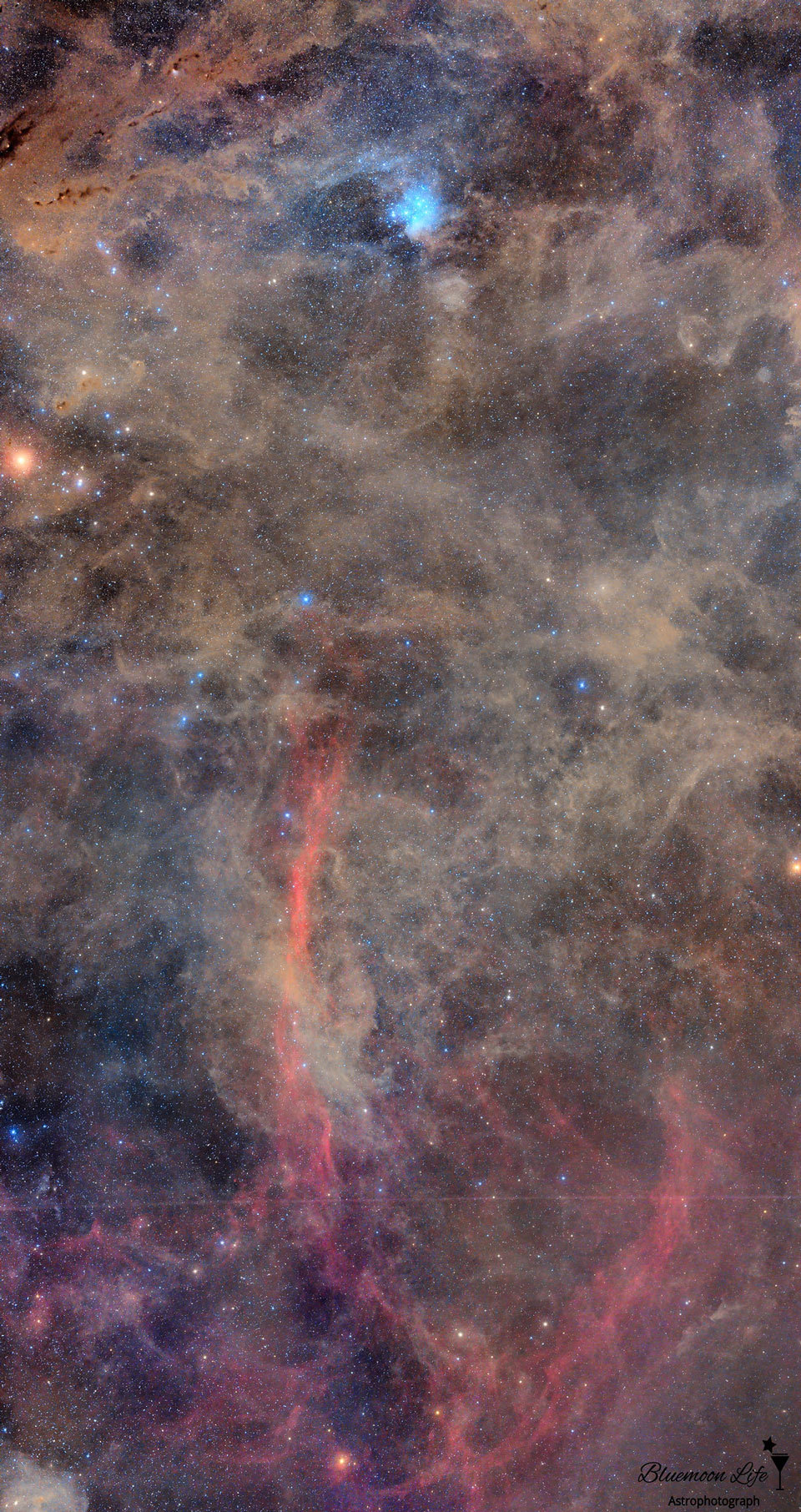
2020 March 23
From the Pleiades to the Eridanus Loop
Image Credit & Copyright: Hirofumi Okubo
Explanation: If you stare at an interesting patch of sky long enough, will it look different? In the case of Pleiades and Hyades star clusters -- and surrounding regions -- the answer is: yes, pretty different. Long duration camera exposures reveal an intricate network of interwoven interstellar dust and gas that was previously invisible not only to the eye but to lower exposure images. In the featured wide and deep mosaic, the dust stands out spectacularly, with the familiar Pleaides star cluster visible as the blue patch near the top of the image. Blue is the color of the Pleiades' most massive stars, whose distinctive light reflects from nearby fine dust. On the upper left is the Hyades star cluster surrounding the bright, orange, foreground-star Aldebaran. Red glowing emission nebula highlight the bottom of the image, including the curving vertical red ribbon known as the Eridanus Loop. The pervasive dust clouds appear typically in light brown and are dotted with unrelated stars.
∞ Source: apod.nasa.gov/apod/ap200323.html
73 notes
·
View notes
Photo


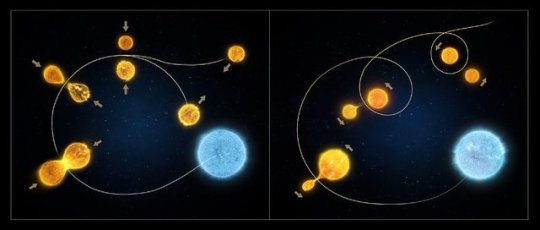
HUBBLE EXPLORES THE FORMATION AND EVOLUTION OF STAR CLUSTERS IN THE LARGE MAGELLANIC CLOUD Just as people of the same age can vary greatly in appearance and shape, so do collections of stars or stellar aggregates. New observations from the NASA/ESA Hubble Space Telescope suggest that chronological age alone does not tell the complete story when it comes to the evolution of star clusters. Previous research on the formation and evolution of star clusters (https://en.wikipedia.org/wiki/Star_cluster) has suggested that these systems tend to be compact and dense when they form, before expanding with time to become clusters of both small and large sizes. New Hubble observations in the Large Magellanic Cloud (https://en.wikipedia.org/wiki/Large_Magellanic_Cloud) (LMC) galaxy have increased our understanding of how the size of star clusters in the LMC changes with time[1]. Star clusters are aggregates of many (up to one million) stars. They are active systems in which the mutual gravitational interactions among the stars change their structure over time (known to astronomers as “dynamical evolution”). Because of such interactions, heavy stars tend to progressively sink towards the central region of a star cluster, while low-mass stars can escape from the system. This causes a progressive contraction of the cluster core over different timescales and means that star clusters with the same chronological age can vary greatly in appearance and shape because of their different “dynamical ages.” Located nearly 160,000 light-years from Earth, the LMC is a satellite galaxy of the Milky Way which hosts star clusters covering a wide range of ages. This differs from our own Milky Way galaxy which primarily contains older star clusters. The distribution of sizes as a function of age observed for star clusters in the LMC is very puzzling, as the young clusters are all compact, while the oldest systems have both small and large sizes. All star clusters, including those in the LMC, have been found to host a special type of re-invigorated stars called blue stragglers (https://en.wikipedia.org/wiki/Blue_straggler) [2]. Under certain circumstances, stars receive extra fuel that bulks them up and substantially brightens them. This can happen if one star pulls matter off a neighbour, or if they collide. As a result of dynamical aging, heavier stars sink towards the centre of a cluster as the cluster ages, in a process similar to sedimentation, called “central segregation.” Blue stragglers are bright, making them relatively easy to observe, and they have high masses, which means that they are affected by central segregation and can be used to estimate the dynamical age of a star cluster [3]. Francesco Ferraro of the University of Bologna in Italy and his team used the Hubble Space Telescope to observe blue stragglers in five (coeval) old LMC star clusters with different sizes and succeeded in ranking them in terms of their dynamical age. “We demonstrated that different structures of star clusters are due to different levels of dynamical ageing: they are in different physical shape despite the fact that they were born at the same cosmic time. This is the first time that the effect of dynamical ageing has been measured in the LMC clusters” says Ferraro. “These findings present intriguing areas for further research, since they reveal a novel and valuable way of reading the observed patterns of LMC star clusters, providing new hints about the cluster formation history in the LMC galaxy,” adds co-author Barbara Lanzoni. Notes [1] The observations were achieved from a set of long exposures acquired with the NASA/ESA Hubble Space Telescope’s Wide Field Camera 3 (WFC3) and Advanced Camera for Surveys (ACS) for five old star clusters in the Large Magellanic Cloud galaxy, secured under proposal 14164 (http://archive.stsci.edu/proposal_search.php?mission=hst&id=14164) (PI: Sarajedini). [2] Blue stragglers are so called because of their blue colour, and the fact that their evolution lags behind that of their neighbours. [3] Blue stragglers combine being relatively bright and having high mass by the standards of globular cluster stars, but they are not the only stars within these clusters that are either bright or massive. TOP IMAGE....This image from the NASA/ESA Hubble Space Telescope reveals an ancient, glimmering ball of stars called NGC 1466. It is a globular cluster — a gathering of stars all held together by gravity — that is slowly moving through space on the outskirts of the Large Magellanic Cloud, one of our closest galactic neighbours. NGC 1466 certainly is one for extremes. It has a mass equivalent to roughly 140 000 Suns and an age of around 13.1 billion years, making it almost as old as the Universe itself. This fossil-like relic from the early Universe lies some 160 000 light-years away from us. NGC 1466 is one of the 5 clusters in the LMC in which the level of dynamical evolution (or "dynamical age") was measured. Credit: ESA/Hubble & NASA CENTRE IMAGE....Blue straggler stars are blue, bright stars, with a higher mass than the average for a cluster, and they are expected to sink towards the centre of a star cluster over time. Those closest to the cluster core are the first to migrate inwards, with more distant blue stragglers progressively moving inwards over time. Credit: ESA/Hubble & NASA, L. Calçada LOWER IMAGE....This illustration demonstrates the two ways that blue stragglers in star clusters form. The illustration on the left shows the collision model where two low-mass stars in an overcrowded environment experience a head-on collision, combining their fuel and mass to form a single hot star. The illustration on the right depicts the "vampire" model consisting of a pair of stars that undergo a transformation, with the lower-mass star draining its larger-mass companion of the hydrogen that fuels its rebirth. Credit: ESA/Hubble, M. Kornmesser
10 notes
·
View notes
Photo
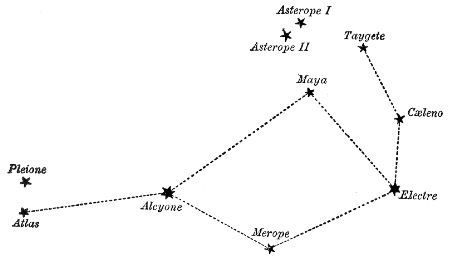
Fig 10. “Pleiades.” 1 Feb. 2008, Wikimedia Commons, commons.wikimedia.org/wiki/Category:Pleiades_(star_cluster)
0 notes
Photo

From SpaceTelescope.Org Picture of the Week; September 11, 2017:
Starbursts in NGC 5398
This NASA/ESA Hubble Space Telescope picture shows NGC 5398, a barred spiral galaxy located about 55 million light-years away.
The galaxy is famous for containing an especially extensive HII region, a large cloud composed of ionised hydrogen (or HII, pronounced “H-two”, with H being the chemical symbol for hydrogen and the “II” indicating that the atoms have lost an electron to become ionised). NGC 5398’s cloud is named Tol 89 and sits at the lower left end of the galaxy’s central “bar” of stars, a structure that cuts through the galactic core and funnels material inwards to maintain the star formation occurring there.
Tol 89 is conspicuous in being the only large massive star forming complex in the entire galaxy, with an extension of roughly 5000 times 4000 light-years; it contains at least seven young and massive star clusters. The two brightest clumps within Tol 89, which astronomers have named simply “A” and “B”, appear to have undergone two bursts of star-forming activity — “starbursts” — roughly 4 million and less than 3 million years ago respectively. Tol 89-A is thought to contain a number of particularly bright and massive stars known as Wolf-Rayet stars, which are known for their high temperatures and extreme stellar winds.
Credit: ESA/Hubble & NASA
#spacetelescope.org#astronomy#hubble#hubble space telescope#galaxy#spiral galaxy#barred spiral galaxy#NGC 5398#h ii region#star forming region#starburst#starburst galaxy#Tol 89#long post
6 notes
·
View notes
Link
The absence of white dwarfs in the Hyades cluster is of interest to astronomers, and this case helps reconstruct the history of the cluster The Hyades star cluster is located about 153 light years away. At such a short distance it is visible to the naked eye in the constellation Taurus. THIS proximity makes it easier for professional astronomers to observe than many other objects. The Hyades cluster contains many stars with approximately the same age - about 625 million years, the same metallicity, and similar trajectories. But it lacks white dwarfs - there are only eight of them in the center of the cluster. The Hyades cluster is quite common. His research greatly helps in understanding star clusters. But such a feature as the almost complete absence of white dwarfs puzzles astronomers. A new study has found one "escapee" from the cluster. This is a white dwarf whose mass is approaching the limiting value for this type of star. The study is called "A White Dwarf That Was Able to Escape the Hyades Star Cluster." [caption id="attachment_68737" align="aligncenter" width="769"] star cluster[/caption] An extremely massive white dwarf was able to escape the Hyades star cluster Clusters such as the Hyades are weakly gravitationally bound, and over time they lose stars through their interactions with gas clouds, other clusters, and between the cluster stars themselves. Study author David Miller of the Department of Physics and Astronomy at the University of British Columbia and his co-authors studied the phenomenon of the absence of white dwarfs in the Hyades to reconstruct the history of the cluster. If we can identify the stars that were expelled, especially white dwarfs in this case, then it is possible to reconstruct the history of the cluster. The European Space Agency's Gaia space telescope tracks more than 1 billion stars in the Milky Way, providing Miller and his colleagues with a huge amount of data. The team found three white dwarfs with trajectories indicating possible escape from the Hyades cluster. For two of them, the range of masses makes it unlikely that they originated in a cluster, but for the third object, it is possible. "We estimate there is a 97.8% probability that the candidate is a true native of the Hyades" White dwarfs have a mass comparable to the Sun, but their size is comparable to the Earth. They consist of degenerate matter and emit only residual thermal energy. This is the final state of about 97% of the stars in the Milky Way. Their mass is governed by the Chandrasekhar limit and at maximum can reach about 1.44 solar masses. Large white dwarfs are usually found in binary star systems and gain mass by pulling matter from a companion; such white dwarfs eventually explode in a type 1a supernova, and all their mass is dissipated. [caption id="attachment_68738" align="alignnone" width="780"] star cluster[/caption] The white dwarf that left the Hyades is called an ultramassive white dwarf. These have a mass of 1.10 or more solar masses. This is well below the Chandrasekhar limit, but well above the average mass of a white dwarf, which is about 0.6 solar masses. Such high-mass objects typically originate from two-parent stars in a binary system, where one star has "taken" material from the other, increasing its mass. However, the Hyades ultramassive white dwarf has a mass of 1.317 solar masses and an age consistent with only one parent star. It appears to be the most massive white dwarf to come from a single progenitor.
#astronomy#astrophysics#celestial_objects#Cosmic#cosmic_objects#Deep_space#Galaxy#globular_cluster#Hubble_Space_Telescope#Milky_Way#night_sky.#open_cluster#sky#Space#star_cluster#star_formation#stargazing#stellar_cluster#stellar_evolution#stellar_grouping#stellar_population#telescope
0 notes
Link
A new release of Gaia data has revealed half a million faint stars in the globular cluster Omega Centauri. This discovery helps fill gaps in maps of the galaxy and will allow scientists to study the structure of the cluster. The European Space Agency (ESA) has unveiled new and improved data about our galaxy and outer space with the release of 5 new pieces of data collected by the Gaia space telescope. Among the mission's findings, the release identified half a million dim stars in the massive Omega Centauri cluster. The new stars discovered by Gaia inhabit one of the densest regions of the sky. The Gaia mission's previous third edition of observations provided information on more than 1.8 billion stars, providing a fairly comprehensive view of the Milky Way and beyond. However, gaps remained in the map of the galaxy. In those areas that are particularly densely “populated” with stars, the usual observing regime reached its limits, which left these areas poorly unexplored - Gaia did not notice dim stars. Globular clusters are a good example of such regions. These clusters, which are among the oldest objects in the Universe, are of particular interest to scientists who study the history of the cosmos. But their bright, star-filled cores can obscure telescopes. Thus, they remain invisible regions on maps of the Universe. [caption id="attachment_66850" align="aligncenter" width="780"] Omega Centauri[/caption] To fill the gaps in Gaia's maps, it chose Omega Centauri, the largest globular cluster visible from Earth and a good example of a "typical" cluster. Instead of focusing just on individual stars, in this survey Gaia used a special observing mode, creating 2D images using the Sky Mapper tool. New Gaia Data Release: Half a Million New Stars in Omega Centauri “In Omega Centauri, we discovered more than half a million new stars that Gaia had not seen before – and that’s just in one cluster,” says lead author Dr. Katja Weingrill, Gaia project leader at the Leibniz Institute for Astrophysics in Potsdam. “The new data has allowed us to discover stars that are so close to each other that they cannot be accurately detected using the regular Gaia survey. With the new data, we will be able to study the structure of the cluster, the distribution of its constituent stars and their motion, and create a complete overview of the Omega Centauri cluster. This was using Gaia’s capabilities to their full potential,” adds co-author and member of the Gaia Collaboration, Dr. Alexey Mints. The discovery exceeds Gaia's normal capabilities, as the Sky Mapper instrument was originally intended only for calibration. The team used an observing mode designed to ensure the smooth operation of all telescope instruments. And I didn’t plan to use it for scientific research. Gaia is now exploring eight more areas using this approach, the results of which will be included in Gaia Data Release 4. The data will help astronomers better understand what's going on inside these cosmic building blocks, helping data scientists pinpoint the age of our galaxy, accurately determine its center, find out how stars change throughout their lives, clarify models of the evolution of galaxies and clarify the age of the Universe. In addition to the major discovery, the new Gaia release also reveals more than 380 possible gravitational lenses, improves the orbits of more than 150,000 asteroids within the solar system, maps the disk of the Milky Way, and characterizes the dynamics of 10,000 binary stars.
#astronomical_observation#astronomy#celestial_object#deep_sky_object.#globular_cluster#Milky_Way#Omega_Centauri#space_exploration#star_cluster#stellar_system
0 notes
Link
Using computer models, scientists were able to simulate the formation of intermediate-mass black holes in star clusters. This opens up new ways to study mysterious objects The Universe is teeming with black holes from stellar masses to supermassive monsters. But there is one class that remains elusive: “average” black holes. They are called intermediate-mass black holes. How common are they, how are they formed and where are they located? To answer these questions, astronomers modeled possible formation scenarios. Intermediate-mass black holes lie in the mass gap between stellar mass and a supermassive black hole. They range from 100 to 100,000 solar masses. If they exist, do they indicate a hierarchical model of black hole formation and do small black holes form from the collapse of supermassive stars? If this is so, then intermediate-mass black holes will be a kind of “transition link” between stellar mass and supermassive black holes. If this idea is correct, then is it possible that intermediate-mass black holes could collide with each other and form the seeds of supermassive black holes? Astronomers need more observational data to answer all these questions. [caption id="attachment_68861" align="aligncenter" width="780"] star clusters[/caption] At the same time, astronomers have enough data on stellar-mass black holes. They are formed during the collapse of supermassive stars. Supermassive black holes located at the centers of galaxies are most likely formed through the accretion of matter, as well as mergers with other black holes. The existence of intermediate-mass black holes appears to be beyond doubt, but their observation presents certain difficulties. This doesn't mean they don't exist. Observers have found candidates for intermediate-mass black holes in the Milky Way. They also appear to be present in active galactic nuclei, where accretion effects are observed. Additionally, some ultraluminous X-ray sources may also have these "average" black holes. The Sloan Digital Sky Survey also found several potential candidates that emit strongly in the X-ray range. X-ray emission is one of the characteristics of activity around a black hole. One of the most interesting observations involves the gravitational waves emitted when two massive black holes merge. As a result, a black hole with a mass of about 150 solar masses was formed - exactly the kind of mass that can be classified as intermediate. Simulation reveals secret of origin of intermediate-mass black holes in star clusters Scientists are sure they exist, but still cannot determine exactly where and how they are formed. An international group led by Arca Sedda from the Gran Sassa Institute (Italy) modeled the possible mechanisms of their formation. [caption id="attachment_68862" align="aligncenter" width="451"] star clusters[/caption] “Current observational limitations do not allow us to say anything definitive about the population of intermediate-mass black holes with masses between 1,000 and 10,000 solar masses, and they cause headaches for scientists regarding the possible mechanisms of their formation,” Sedda explained. Sedda and his team looked at star clusters as possible birthplaces for intermediate-mass black holes, and they created computer models that could simulate the formation of these mysterious objects using DRAGON-II data. This is a collection of 19 computer models representing dense clusters of up to a million stars each. Using these in further simulations, the team discovered that the objects they were interested in could form star clusters. This occurs due to a complex combination of three factors: mergers between stars much more massive than the Sun, accretion of matter from the star onto stellar-mass black holes, and mergers between stellar-mass black holes. "The latter process makes it possible to 'see' these phenomena through the detection of gravitational waves," Sedda explained. The team also hypothesized what happens after the birth of intermediate-mass black holes. They appear to be ejected from their clusters by complex gravitational interactions, or experience "relativistic recoil" when formed. This keeps them from gaining weight. “Our models show that although seeds form naturally from interactions in star clusters, they are unlikely to become heavier than a few hundred solar masses unless the parent cluster is extremely dense or massive,” Sedda said. Finding out the history of the origin of these black holes still does not answer the question of whether they are the missing link between stellar and supermassive black holes. For a better understanding, we need two ingredients: one or more processes capable of forming black holes in the intermediate mass range and the ability to preserve such black holes. Our study places strict constraints on the first ingredient, providing clear insight into what processes may contribute to the formation of intermediate-mass black holes. Looking at more massive clusters containing more binary star systems in the future may be the key to obtaining the second ingredient. But this will require enormous effort from a technological and computational point of view.
#astronomy#astrophysics#celestial_objects#Cosmic#cosmic_objects#Deep_space#Galaxy#globular_cluster#Hubble_Space_Telescope#Milky_Way#night_sky.#open_cluster#sky#Space#star_clusters#star_formation#stargazing#stellar_cluster#stellar_evolution#stellar_grouping#stellar_population#telescope
0 notes
Photo

2020 January 22
The Hyades Star Cluster
Image Credit & Copyright: Jose Mtanous
Explanation: It is the closest cluster of stars to the Sun. The Hyades open cluster is bright enough to have been remarked on even thousands of years ago, yet is not as bright or compact as the nearby Pleiades (M45) star cluster. Pictured here is a particularly deep image of the Hyades which has brings out vivid star colors and faint coincidental nebulas. The brightest star in the field is yellow Aldebaran, the eye of the bull toward the constellation of Taurus. Aldebaran, at 65 light-years away, is now known to be unrelated to the Hyades cluster, which lies about 150 light-years away. The central Hyades stars are spread out over about 15 light-years. Formed about 625 million years ago, the Hyades likely shares a common origin with the Beehive cluster (M44), a naked-eye open star cluster toward the constellation of Cancer, based on M44's motion through space and remarkably similar age.
∞ Source: apod.nasa.gov/apod/ap200122.html
92 notes
·
View notes
Photo


COSMIC COLLISION LIGHTS UP THE DARKNESS Though it resembles a peaceful rose swirling in the darkness of the cosmos, NGC 3256 is actually the site of a violent clash. This distorted galaxy is the relic of a collision between two spiral galaxies, estimated to have occurred 500 million years ago. Today it is still reeling in the aftermath of this event. Located about 100 million light-years away in the constellation of Vela (https://en.wikipedia.org/wiki/Vela_(constellation)) (The Sails), NGC 3256 is approximately the same size as our Milky Way and belongs to the Hydra-Centaurus Supercluster (https://en.wikipedia.org/wiki/Hydra-Centaurus_Supercluster). It still bears the marks of its tumultuous past in the extended luminous tails that sprawl out around the galaxy, thought to have formed 500 million years ago during the initial encounter between the two galaxies, which today form NGC 3256. These tails are studded with young blue stars, which were born in the frantic but fertile collision of gas and dust. When two galaxies merge (https://en.wikipedia.org/wiki/Galaxy_merger), individual stars rarely collide because they are separated by such enormous distances, but the gas and dust of the galaxies do interact -- with spectacular results. The brightness blooming in the centre of NGC 3256 gives away its status as a powerful starburst galaxy (https://en.wikipedia.org/wiki/Starburst_galaxy), host to vast amounts of infant stars born into groups and clusters. These stars shine most brightly in the far infrared, making NGC 3256 exceedingly luminous in this wavelength domain. Because of this radiation, it is classified as a luminous infrared galaxy (http://ieeexplore.ieee.org/document/7283742/?reload=true). NGC 3256 has been the subject of much study due to its luminosity, its proximity, and its orientation: astronomers observe its face-on orientation, that shows the disc in all its splendour. NGC 3256 provides an ideal target to investigate starbursts (https://en.wikipedia.org/wiki/Starburst_region) that have been triggered by galaxy mergers. It holds particular promise to further our understanding of the properties of young star clusters (https://en.wikipedia.org/wiki/Star_cluster) in tidal tails (https://en.wikipedia.org/wiki/Tidal_tail). As well as being lit up by over 1,000 bright star clusters, the central region of NGC 3256 is also home to crisscrossing threads of dark dust and a large disc of molecular gas spinning around two distinct nuclei -- the relics of the two original galaxies. One nucleus is largely obscured, only unveiled in infrared, radio and X-ray wavelengths. These two initial galaxies were gas-rich and had similar masses, as they seem to be exerting roughly equal influence on each other. Their spiral disks are no longer distinct, and in a few hundred million years time, their nuclei will also merge and the two galaxies will likely become united as a large elliptical galaxy (https://en.wikipedia.org/wiki/Elliptical_galaxy). NGC 3256 was previously imaged (http://www.spacetelescope.org/images/heic0810ar) through fewer filters by the NASA/ESA Hubble Space Telescope as part of a large collection of 59 images of merging galaxies (https://www.spacetelescope.org/news/heic0810), released for Hubble’s 18th anniversary on 24th April 2008. TOP IMAGE....This ground-based image shows the spiral galaxy NGC 3256 and its surroundings. Credit: NASA, ESA, Digitized Sky Survey 2; Acknowledgement: Davide De Martin LOWER IMAGE....This image, taken with the Wide Field Camera 3 (WFC3) and the Advanced Camera for Surveys (ACS), both installed on the NASA/ESA Hubble Space Telescope, shows the peculiar galaxy NGC 3256. The galaxy is about 100 million light-years from Earth and is the result of a past galactic merger, which created its distorted appearance. As such, NGC 3256 provides an ideal target to investigate starbursts that have been triggered by galaxy mergers. Credit: ESA/Hubble, NASA
4 notes
·
View notes
Photo
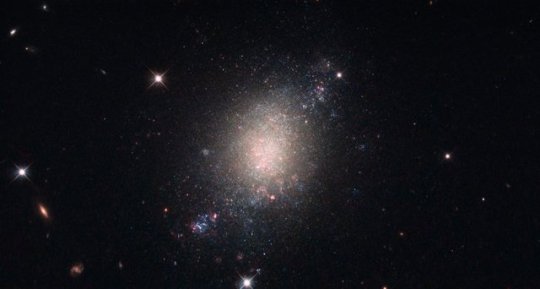
From SpaceTelescope.Org Picture of the Week; June 19, 2017:
Surveying The Cosmos
The object in the middle of this image, sitting alone within a star-studded cosmos, is a galaxy known as ESO 486-21. ESO 486-21 is a spiral galaxy — albeit with a somewhat irregular and ill-defined structure — located some 30 million light-years from Earth.
The NASA/ESA Hubble Space Telescope observed this object while performing a survey — the Legacy ExtraGalactic UV Survey (LEGUS) — of 50 nearby star-forming galaxies. The LEGUS sample was selected to cover a diverse range of galactic morphologies, star formation rates, galaxy masses, and more. Astronomers use such data to understand how stars form and evolve within clusters, and how these processes affect both their home galaxy and the wider Universe. ESO 486-21 is an ideal candidate for inclusion in such a survey as it is known to be in the process of forming new stars, which are created when large clouds of gas and dust (seen here in pink) within the galaxy crumple inwards upon themselves.
LEGUS made use of Hubble’s Wide Field Camera 3 (WFC3) and Advanced Camera for Surveys (ACS). The WFC3 obtained detailed observations of the target objects while the ACS obtained what are known as parallel fields — instead of leaving ACS idle, it was instead trained on a small patch of sky just offset from the target field itself, allowing it to gather additional valuable information while the primary target was being observed by WFC3. Parallel fields played an important role in Hubble’s Frontier Fields programme, which used the magnifying power of large galaxy clusters (via a phenomenon known as gravitational lensing) to explore objects in the distant Universe.
Credit: ESA/Hubble & NASA
#spacetelescope.org#astronomy#hubble#hubble space telescope#galaxy#spiral galaxy#ESO 486-21#LEGUS#Legacy ExtraGalactic UV Survey#long post
2 notes
·
View notes
Photo
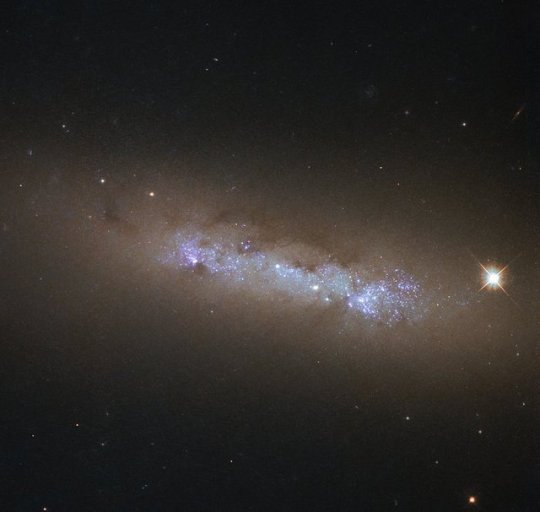
From SpaceTelescope.Org Picture of the Week; July 24, 2017:
A Cosmic Atlas
This beautiful clump of glowing gas, dark dust, and glittering stars is the spiral galaxy NGC 4248, located about 24 million light-years away in the constellation of Canes Venatici (The Hunting Dogs).
This image was produced by the NASA/ESA Hubble Space Telescope as it embarked upon compiling the first Hubble ultraviolet “atlas”, for which the telescope targeted 50 nearby star-forming galaxies. A sample spanning all kinds of different morphologies, masses, and structures. Studying this sample can help us to piece together the star-formation history of the Universe.
By exploring how massive stars form and evolve within such galaxies, astronomers can learn more about how, when, and where star formation occurs, how star clusters change over time, and how the process of forming new stars is related to the properties of both the host galaxy and the surrounding interstellar medium (the “stuff” that fills the space between individual stars).
This image is formed of observations from Hubble’s Wide Field Camera 3.
Credit: ESA/Hubble & NASA
#spacetelescope.org#astronomy#hubble#hubble space telescope#galaxy#spiral galaxy#NGC 4248#star formation#long post
1 note
·
View note
Photo
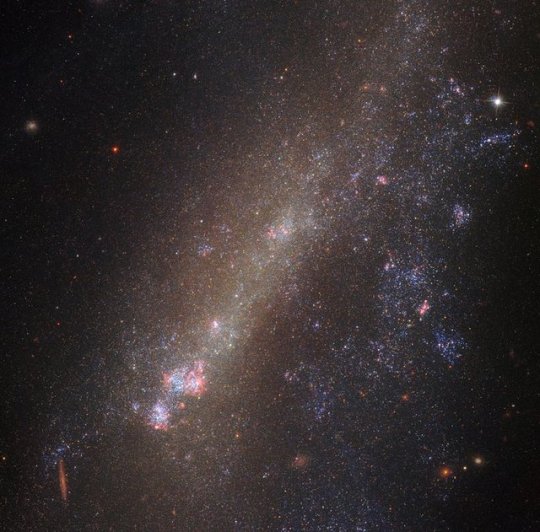
From SpaceTelescope.Org Picture of the Week; August 14, 2017:
A Distorted Duo
Gravity governs the movements of the cosmos. It draws flocks of galaxies together to form small groups and more massive galaxy clusters, and brings duos so close that they begin to tug at one another. This latter scenario can have extreme consequences, with members of interacting pairs of galaxies often being dramatically distorted, torn apart, or driven to smash into one another, abandoning their former identities and merging to form a single accumulation of gas, dust, and stars.
The subject of this NASA/ESA Hubble Space Telescope image, IC 1727, is currently interacting with its near neighbour, NGC 672 (which is just out of frame). The pair’s interactions have triggered peculiar and intriguing phenomena within both objects — most noticeably in IC 1727. The galaxy’s structure is visibly twisted and asymmetric, and its bright nucleus has been dragged off-centre.
In interacting galaxies such as these, astronomers often see signs of intense star formation (in episodic flurries known as starbursts) and spot newly-formed star clusters. They are thought to be caused by gravity churning, redistributing, and compacting the gas and dust. In fact, astronomers have analysed the star formation within IC 1727 and NGC 672 and discovered something interesting — observations show that simultaneous bursts of star formation occurred in both galaxies some 20 to 30 and 450 to 750 million years ago. The most likely explanation for this is that the galaxies are indeed an interacting pair, approaching each other every so often and swirling up gas and dust as they pass close by.
Credit: ESA/Hubble & NASA
#spacetelescope.org#astronomy#hubble#hubble space telescope#galaxy#interacting galaxies#IC 1727#long post
0 notes
Photo
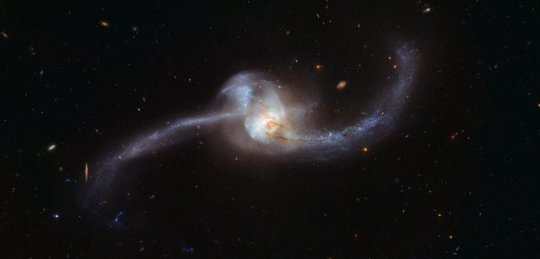
From SpaceTelescope.Org Picture of the Week; October 16, 2017:
A Glimpse Of The Future
This image, captured by the NASA/ESA Hubble Space Telescope, shows what happens when two galaxies become one. The twisted cosmic knot seen here is NGC 2623 — or Arp 243 — and is located about 250 million light-years away in the constellation of Cancer (The Crab).
NGC 2623 gained its unusual and distinctive shape as the result of a major collision and subsequent merger between two separate galaxies. This violent encounter caused clouds of gas within the two galaxies to become compressed and stirred up, in turn triggering a sharp spike of star formation. This active star formation is marked by speckled patches of bright blue; these can be seen clustered both in the centre and along the trails of dust and gas forming NGC 2623’s sweeping curves (known as tidal tails). These tails extend for roughly 50 000 light-years from end to end. Many young, hot, newborn stars form in bright stellar clusters — at least 170 such clusters are known to exist within NGC 2623.
NGC 2623 is in a late stage of merging. It is thought that the Milky Way will eventually resemble NGC 2623 when it collides with our neighbouring galaxy, the Andromeda Galaxy, in four billion years time.
In contrast to the image of NGC 2623 released in 2009 (heic0912), this new version contains data from recent narrow-band and infrared observations that make more features of the galaxy visible.
Credit: ESA/Hubble & NASA
#spacetelescope.org#astronomy#hubble#hubble space telescope#galaxy#galaxy collision#merging galaxies#NGC 2623#Arp 243#tidal tail#long post
0 notes